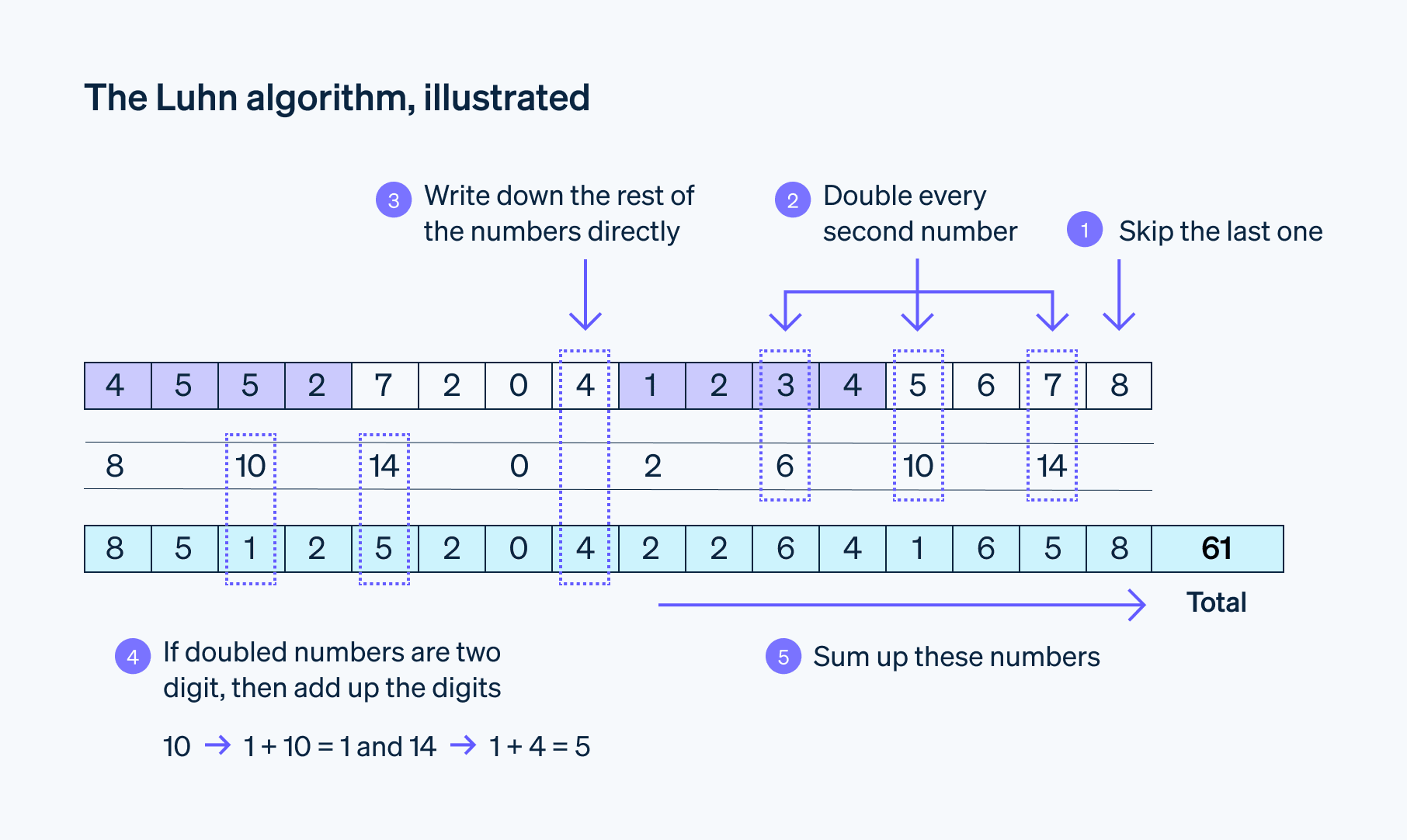Luhn 算法,也被称为 Luhn 公式、“模 10”或“mod 10”算法,是一个简单的校验和公式,用于验证身份证号码。该算法由 IBM 工程师 Hans Peter Luhn 开发,可用于验证信用卡号码、国际移动设备识别码 (IMEI) 号码和其他数字数据。企业经常依赖 Luhn 算法来提高数据输入过程的准确性和可靠性,特别是在处理支付数据等敏感信息时。
下面,我们将分享企业需要了解的有关 Luhn 算法的信息:它是什么、为什么如此重要以及如何使用它来提高客户支付的安全性。
目录
- Luhn 算法公式
- 为什么 Luhn 算法如此重要?
- Luhn 算法验证哪些类型的数字?
- 不同行业如何使用 Luhn 算法?
- Luhn 算法局限性
- Stripe Radar 如何提供帮助
Luhn 算法公式
Luhn 算法没有传统数学意义上的公式。相反,它由一系列步骤构成。
第 1 步:从右边开始,将倒数第二个数字的值加倍,然后继续对每第二个数字执行相同的操作。如果任何加倍运算的结果大于 9,则将运算结果的数位相加,得到一个个位数。
示例:6 × 2 = 12; 1 + 2 = 3第 2 步:将所有未加倍的数字与加倍后的新数值相加。
第 3 步:确定总和是否是 10 的倍数。根据 Luhn 算法,如果总数以 0 结尾,则认为该数字有效。
为了说明这一点,让我们使用 Luhn 算法公式验证数字 79927398713。
从右边开始,每第二个数字加倍:
1 x 2 = 2
8 x 2 = 16 (1 + 6 = 7)
3 × 2 = 6
2 × 2 = 4
9 x 2 = 18 (1 + 8 = 9)
将所有数字相加,包括未加倍的数字:
7 + 9 + 9 + 4 + 7 + 6 + 9 + 7 + 7 + 2 + 3 = 70
根据 Luhn 算法,数字 79927398713 是有效的,因为结果是 70,是 10 的倍数。
这些步骤构成了 Luhn 算法验证或生成数字所遵循的“公式”或程序。

为什么 Luhn 算法如此重要?
Luhn 算法在数据验证和欺诈预防方面成为了多行业的游戏规则改变者,尤其是在金融、支付和政府服务领域。
以下是结算页面至关重要的原因:
提高了数据准确性:Luhn 算法是一种检测常见输入错误类型(如个位数错误或将两位数颠倒的换位错误)的直接方法,这在金融和银行等行业尤为重要。
易于实施:该算法简单易懂,可在各种编程语言中实现,无需大量计算资源,因此可广泛应用。
实时功能:Luhn 算法可实时应用于验证输入的数字数据的正确性,已成为需要即时验证数据的系统的重要检查手段。
欺诈预防: 虽然无法对复杂的欺诈尝试提供万无一失的保护,Luhn 算法仍然可以作为第一道防线。在交易或操作进行之前,它有助于筛选出无效号码,这可以阻止欺诈企图,并减少可能导致欺诈或安全漏洞的错误发生率。
成本效益:该算法通过在流程早期发现错误,有助于避免与错误数据处理相关的成本,如经济损失、客户不满以及纠正错误的管理成本。
全球影响力: 由于其高效性和简单性,Luhn 算法已被全球主要信用卡公司、政府机构和金融机构广泛采用用于 ID 号码验证。
Luhn 算法已成为验证信用卡和敏感数据的有效工具,通过检测错误、防止欺诈和确保准确的交易实现这些功能。易于实施和实时验证使其成为支付处理和金融系统中的关键安全措施。
Luhn 算法验证哪些类型的数字?
在任何手动输入数字的系统中,Luhn 算法都可以用作实时验证工具,以立即检测和突出显示错误,从而提高数据质量和运营效率。在进一步处理之前,它确保数字序列在结构上是有效的。
以下是它通常验证的数字序列类型概述:
信用卡号码:Luhn 算法最常见的用途是验证信用卡号码。在处理信用卡交易之前,会根据 Luhn 算法检查卡号以确认它是一个有效的序列。这一步骤有助于检测意外输入错误或不完整的号码。几乎所有信用卡都包含一个 Luhn 校验。
识别号码:Luhn 算法用于验证社会保险号、手机 IMEI 号码、国民身份证号码等身份证号。此验证将检查这些数字是否已正确输入和处理。
财务标识符: 许多银行和金融机构在处理诸如资金转账等交易之前,会使用 Luhn 算法来验证账户号码和其他金融标识符,如路径号码。
条形码: 一些条形码格式,如 EAN 和 UPC 代码,使用 Luhn 算法计算校验位。扫描仪使用该算法来验证条形码扫描是否正确,从而实现更准确的库存跟踪、零售结账和物流操作。
不同行业如何使用 Luhn 算法?
Luhn 算法在多个行业中被用于验证关键的数值数据,防止意外输入错误,并增强防欺诈保护。
下面简要介绍一下 Luhn 算法在实践中的一些常见工作方式:
网上购物:当您在网上购物时,支付系统会在处理交易之前使用 Luhn 算法验证您输入的信用卡号码是否有效。这有助于减少因输入错误或数字不正确而导致的支付被拒。
银行系统: 银行和信用卡公司使用 Luhn 算法来验证账号和路径号码,以确保资金被转入正确的账户。这确保在处理电子资金转账 (EFT) 或 ACH 付款之前,资金被转移到有效的金融账户。
手机:国际移动设备识别码 (IMEI) 可唯一识别移动设备,其中包括一个使用 Luhn 算法从其他数字中计算出的校验数位。这有助于验证 IMEI 号码的完整性,有助于在购买二手手机时防止欺诈和识别设备。
政府文件:在某些国家/地区,社会安全号码或国民身份证号码等身份证号码包含一个使用 Luhn 算法计算的校验位。这有助于政府机构在税务记录、社会福利和文件签发的过程中核实这些数字在数据录入和处理中的准确性。
公用事业公司:公用事业服务提供商通常使用 Luhn 算法来验证客户帐号。这可确保计费和付款信息与正确的账户相关联,从而减少计费错误和客户服务问题。
票务系统: 航空公司、铁路公司和其他交通公司使用 Luhn 算法来验证预订参考号或票号,确保数据输入正确,并降低出票欺诈的风险。
Luhn 算法的局限性
虽然 Luhn 算法是用于错误检测和数值验证的强大工具,但它有一定的局限性。当涉及到欺诈检测或数据验证时,Luhn 算法通常只是更广泛的一套检查和平衡机制中的一部分,不应单独依赖于安全关键的应用程序。
以下是 Luhn 算法的一些关键限制:
复杂的错误检测: 该算法旨在捕捉常见错误,例如单个数字的错误输入或相邻数字的换位(例如,67 变为 76),但它无法检测更复杂的错误,例如非相邻数字的交换(例如,197 变为 971)或序列中多个数字的错误。
欺诈检测:Luhn 算法可以验证数字序列是否可能有效,但无法确定它是否对应于合法账户或身份,也无法防范蓄意欺诈活动,即欺诈行为人拥有有效的数字序列。
非数字数据: 该算法仅适用于数值数据,不能用于验证包含字母、符号、特殊字符或字母数字标识符的数据。
数据完整性: 该算法仅检查数值有效性,但不验证数据完整性。它无法检测数据是否被故意更改或识别数据的哪一部分不正确。
可预测性:该算法是一种众所周知的标准方法,任何了解该算法的人都可以生成通过 Luhn 检查的数字。在需要更高的安全级别时,这种可预测性可能会成为一个缺点。
网络安全的有限应用: 因为 Luhn 校验不加密或隐藏数据,所以它不能提供对抗恶意攻击(例如黑客攻击、网络钓鱼或数据泄露)的安全保护。其他安全措施,如加密、多因素验证 (MFA) 和人工智能驱动的欺诈检测,也应与其一起使用。
尽管存在这些局限性,但 Luhn 算法仍然是各种应用中,尤其是金融服务领域,对数字序列进行初步检查的一种广泛使用的工具。当与额外的安全和验证流程相结合时,它可以帮助提高数据准确性,并防止数字序列中的意外错误。
Stripe Radar 如何提供帮助
Stripe Radar 使用经过训练的人工智能模型来检测和预防欺诈,这些模型利用来自全球 Stripe 网络的数据。它根据最新的欺诈趋势不断更新这些模型,在欺诈手段演变时保护您的企业。
Stripe 还提供 Radar 风控团队版,该版本允许用户添加特定于其业务的自定义欺诈场景识别规则,并支持获得高级欺诈洞察力。
Radar 可以帮助您的商家:
- 预防欺诈损失: Stripe 每年处理超过 1 万亿美元的支付。这种规模使 Radar 能够准确检测和预防欺诈,为您节省资金。
- 提高收入: Radar 的人工智能模型接受了实际争议数据、客户信息、浏览数据等的训练。这使 Radar 能够识别高风险交易并减少误报,从而增加您的收入。
- 节省时间: Radar 内置在 Stripe 中,无需编写任何代码即可设置。您还可以在一个平台上监控欺诈表现、编写规则等,提高效率。
本文中的内容仅供一般信息和教育目的,不应被解释为法律或税务建议。Stripe 不保证或担保文章中信息的准确性、完整性、充分性或时效性。您应该寻求在您的司法管辖区获得执业许可的合格律师或会计师的建议,以就您的特定情况提供建议。